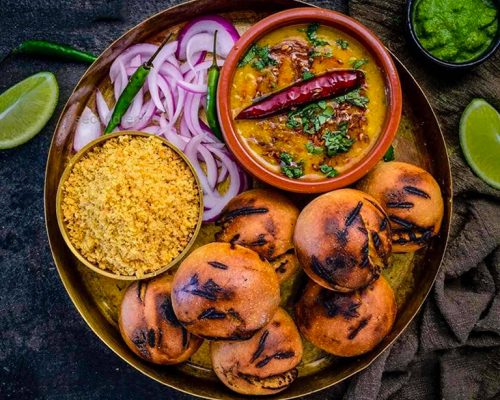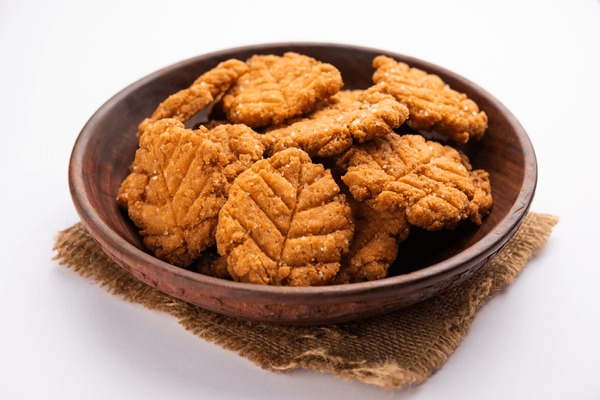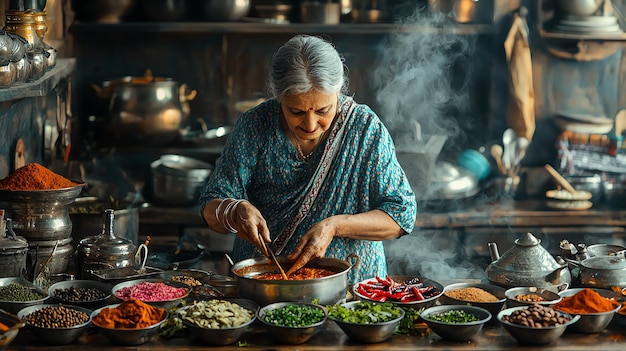Introduction –Taste of India
Welcome to Grandmother’s Kitchen, where food isn’t just food — it’s memory, love, and heritage. The Taste of India begins here, where every recipe tells a story of spices, warmth, and tradition.
Even when you wake up with the aroma of curry leaves, sizzling mustard seeds, and the fresh-brewed filter coffee fills the air, if you’re in your grandmother’s place. Am I Right?
When entering the kitchen, your mom is cooking, and there will be a recipe book of grandmother’s spices, which your mom says proudly.
India’s taste isn’t just in its food; it’s a culture. Each state, each household, each grandmother carries a recipe that tells a tale of history, tradition, and pride.
Where are you from?
I am from Tamil Nadu with the taste of fiery sambar and Kerala’s creamy avial to Punjabi dal and Bengal’s sweet in our plate, like maps filled with stories of land, and the taste of food flows like a river.
Are you a food lover? Then get ready to come along with me as we travel across the taste of India through its kitchen’s secret recipe.
That remembers the taste, flavours, and bends with a delicious culture throughout its journey in grandmother’s pot.
The Temple of Tastes: Tamil Nadu
Let’s start with my hometown, where my grandmother wakes up at dawn, makes herself ready for the day, and then moves to the kitchen for the food preparation.In Tamil Nadu, the morning aroma of idlis, dosa, and sambar defines the southern Taste of India — simple, soulful, and full of flavor.
We are used to meeting here only during festival season, where we see a smile when we arrive at her home.

The traditional grinding batter on stone grinders, their hands moving in rhythm, and her humming sound make a beautiful morning.
starting breakfast on a banana leaf with the aroma of steaming idlis, crisp dosa, spicy sambar, also her spice chutney.
Make the day start with taste, it’s mind-blowing
It’s just the beginning, then from Pongal to rasam with her sweet smile of payasam, balance the taste and flavour, with a deeply satisfying.
Grandmother’s Tip:
“Never waste rice water because use it for fermentation, that’s how the idli smiles in the morning.”
The Land of Coconut: Kerala
Coconut milk, curry leaves, and spices come together in Kerala’s aviyal, representing the coastal Taste of India at its finest.
Kerala is famous for its coconut-rich recipes in every food, even when it comes to oil.
Every food in Kerala, even if it’s a sweet, you can taste the presence of coconut oil in it, that the flavour.

Every house has its own recipe, cooks slowly, letting the coconut milk simmer until the taste is enhanced by the spices, to embrace it.
A Sunday feast is incomplete without aviyal, fish curry, thoran, and a drizzle of ghee over hot red rice.
During Onam, the kitchen becomes a temple of abundance, with dishes like olan, kootu curry, and payasam spread across a banana leaf in perfect harmony.
Grandmother’s Tip:
“Never rush coconut milk; let it rest. Good things take time, like flavors.”
The Spice of Pickles: Andhra Pradesh & Telangana
If you’re craving for something spicy that burns your tongue and tears from your eyes, then don’t miss it.The fiery curries of Andhra and Telangana bring the boldest Taste of India, where spice meets tang and passion.

Grandmothers here are masters of chilli, tamarind, and tangy balance.
Their sorrel leaf chutney, as gongura pachadi, and the spicy dal, as pappu pulusu, are household legends of every family in Andhra.
Meals often balance the spicy, but never harsh, it’s a beautiful combination with cool curd rice, and the crispy papads make you wonder the flavours.
Even snacks like murukulu and spice powder, as karam podi, are homemade, stored in jars, and you can find them in everyone’s kitchen.
Grandmother’s Tip:
“The right spice doesn’t burn; it wakes up your tongue.”
The Balance of Sweet: Karnataka
Karnataka’s taste carries both luxury for royals and homely food with simplicity.
Even a sweet named after the famous city of Mysore, that’s Mysore Pak, blends with the flavour of sweetness and melts on your tongue.
Don’t miss it when you visit.

Grandmothers here never forget the final touch with a spoonful of ghee that seals the meal with comfort.From Bisi Bele Bath to Mysore Pak, Karnataka blends comfort and sweetness in the Taste of India.
Grandmother’s Tip:
“Feed others before you eat; the food tastes better when shared with loved ones.”
A Sweet Twist to Every Bite: Gujarat
As we know, Karnataka is known for its sweetness, and Andhra for spicy. If it’s combined, here comes Gujarat by balancing both flavors of taste.In Gujarat, the Taste of India balances sweetness and spice through dhokla, kadhi, and thepla — food that feels like a smile.
No other state balances sweetness and spice quite like Gujarat.

Gujarat thali is a celebration itself made with flavoured dal, kadhi, thepla, dhokla, and undhiyu, served with love and laughter.
Their kitchen is always busy, but peaceful, filled with the sound of making dough, it’s been rolled, and ghee sizzling on the tawa, the sound of it makes the most peaceful and sweet.
Grandmother’s Tip:
“Add a little jaggery in your life, like food, should always have sweetness and also life.”
The Land of Butter: Punjab
Punjab people are always enriched by their generosity with flavour. Punjab offers the hearty Taste of India — dripping with ghee, butter, and warmth that fills both the plate and the heart.
If generosity has a flavour for taste, then it would be the Punjab food. If you’re on a calorie-cut, then don’t try Punjabi Food.
Grandmothers here cook with love and care, with ladles of ghee, chunks of butter, and a pinch of pride.
Sweetness comes like a children’s nickname, as a chubby child, like laddu, and chubby cheeks like Rasa Gulla.

one is made with chickpea flour with sweetness and a lot of ghee to make it, and the other comes with a ball dipped in sugar syrup made with milk.
From sarson da saag to Makki di roti, and rajma chawal to lassi, every dish is hearty and full of love.
In Punjab, Food is never just food; it’s a service. Every guest leaves full, body and soul.
Grandmother’s Tip:
“Never say no to more ghee, it keeps your heart happy, filled with love.”
Food lover’s paradise: West Bengal
In Bengal, cooking is an art where the kitchen is like a canvas and every meal feels like a poem written with the flavour of taste.
Mustard oil, fish, and sweets — Bengal adds poetry to the Taste of India with dishes like machher jhol and mishti doi
In every kitchen, the mustard oil, poppy seeds, and fish farm make it fresh and flavoured.
The sweetness of Mishti Doi, a sweet yogurt, makes it melt on your tongue with the milky flavour and taste like a delight of milk.

Their fish curry, as machher jhol, steamed potato with spicy aloo posto, and Mishti Doi, a sweet yogurt, are legendary in Bengal
And every festive meal feels like storytelling through taste, soulful, rhythmic, and full of emotion.
Grandmother’s Tip:
“Taste before you serve the food must first make you happy.”
Royal Flavors: Rajasthan
Rajasthan is a Desert known as the Land of Kings, and its cuisine is born from scarcity with hardship into artistry.
Even the desert brings magic to the Taste of India, where dal bati churma and gatte ki sabzi turn scarcity into flavor.
Grandmothers here knew how to preserve flavour even in the desert, using dried lentils, spices, and ghee to create magic.
Dal Bati churma is a traditional meal made with savoury dal and deep-fried wheat dough, Ker sangriIt combines dried Ker berries and sangri beans into spicy and tangy vegetables cooked with spices, making it crunchy.

Gatte ki sabzi is a Rajasthani curry recipe made with besan sausages cooked in a spicy yogurt-based gravy
They are symbols of resilience and richness with flavour in their scarcity.
How come without sweet?
Even their sweets, like ghewar, are also known as a honeycomb dessert, and mohanthal with besan flour mixed with sugar syrup makes it taste sweet; it also carries stories of royal kitchens and festive joy.
Grandmother’s Tip:
“Don’t waste any food; in every crumb, there’s flavour waiting for you.”
Heritage on a Feast Plate: Uttar Pradesh
Uttar Pradesh is known for its diverse and rich culture for food, which is influenced by Mughlai and Awadhi traditions.
The Mughlai-inspired biryanis and chaats of Uttar Pradesh offer a royal Taste of India that connects the past and present.
The Food speaks from the streets of Lucknow to the ghats of Varanasi, Uttar Pradesh, cooks with emotion and elegance.
From the street food chaat and bedmi puri to rich sweets like petha and shahi tukda, the food is rich and flavours vary by region.

Grandmothers in UP treat cooking like devotion, slow, deliberate, and full of fragrance.
Whether it’s a kachori or a Lucknow biryani, every bite tells its story of culture that blends with the grace of the Mughals.
Grandmother’s Tip:
“Let the aroma guide you. When the air smells right, your dish is done.”
Land of Bihari cuisine
Bihar’s food culture is known for its savory dishes, like baked, stuffed with sattu, flavoured with tomatoes make their dish as their region’s identity.
Bihar’s sattu paratha and litti chokha add a rustic touch to the Taste of India, humble yet unforgettable.
In Bihar, food is simple but soulful, with dishes like sattu paratha, which is a flat bread mixed with spices and baked.
Thekua it’s a deep-fried sweet cookie, a sacred offering during the Chhath Puja festival, that is our everyday treasure.

Litti Chokha is a dish of baked, stuffed wheat balls served with a side of chokha, a mash of roasted eggplant and tomatoes. It is a significant part of the local culture.
Grandmother’s Tip:
“Add your smile to the meal, that’s the best seasoning.”
Let Your Taste Buds Travel India
India’s food is a map, and grandmothers are its compass.
From Kerala’s coconut curries to Punjab’s buttery breads, every kitchen carries the Taste of India — a flavor that unites hearts and generations.
Then you must be the person who carries both the map and the compass,
Grab your bag and start to enjoy every flavour of food in India
Discover recipes, stories, and the love that only a grandmother’s hands can create.
Start to travel through the kitchens of every state
FAQs About State Food & Grandmother’s Cooking
1. Why does each Indian state have a unique cuisine?
Because of its geography, climate, culture, and local ingredients, each state developed its own food identity.
2. What makes grandmother’s cooking so special?
It’s made with patience, tradition, and instinct, not measurements but emotions.
3. Are traditional state foods still made today?
Yes! Many homes still preserve these recipes, often blending them with modern techniques.
4. How can I cook like my grandmother?
Start slow — understand ingredients, cook by feel, and taste as you go.
5. Why are Indian thalis so famous?
They represent a complete mix of flavours, nutrition, and regional pride.



